Strange fossil assemblage in a chert
sample
More or less well preserved land plants, algae, fungi,
microbes, creatures, and "enigmatic organisms"
[1]
have been found in the fossiliferous chert from
Rhynie. Every chert sample offers at least one of these items, and most
often more of them are seen near each other. There are rare and not yet
named species among the kinds of fossils listed above, perhaps with the
exception of the land plants, whose 7 described species could well be
the only ones in that Early Devonian
habitat. Samples showing rare species
combined give rise to wonder. One of such has provided the images
discussed in Rhynie
Chert News 29,
51,
101,
and in this
contribution.
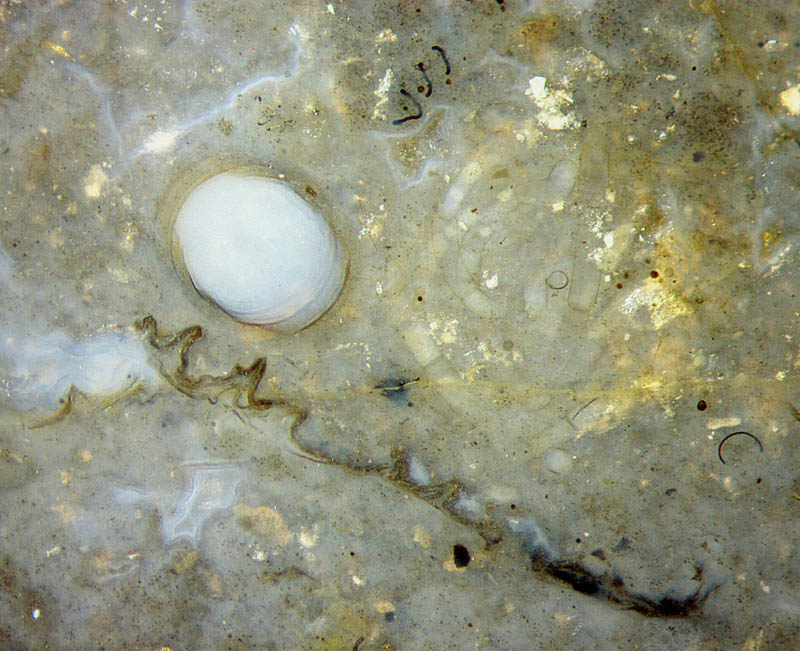
Fig.1: Assemblage of quite different fossils,
including Nematoplexus,
one of the "enigmatic organism" in [1],
confusing at first sight,
on the cut face of a Rhynie chert sample of 0.28kg.
Width of the picture 4mm.
Shown here is a unique assemblage of
fossils, two of them being highly interesting: fragments
of screw-like Nematoplexus, a
non-typical charophyte alga, a moult of the
crustacean Castracollis,
and a big ruffled sheet below.
Most conspicuous is the slightly inclined section of the lengthy
cylindrical body of Castracollis
(or its moult), contrasting to its "dirty" vicinity.
Clearly seen below right is a fragment of a screw-like tube of Nematoplexus, screw
diameter about 0.2mm, which is compatible with the majority of Nematoplexus screws
in this sample.
The deformed screw-like
tube with three turns seen above, with the
upper halves of two turns cut off, reveals a
surprise if magnified (Fig.2): A sleek
screw-like tube, 0.07mm thread width, 6µm thick, is wound around one
turn of
the big tube of 17µm thickness.
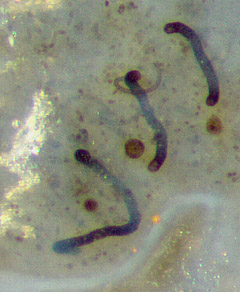
Fig.2: Two different screw-like Nematoplexus
tubes,
the big one deformed, two upper halves cut off, intertwined with a tiny
screw with two turns seen, the upper one clearly, the lower one very
faintly in the depth.
Width of the picture 0.4mm.
The sample contains more scattered fragments of the tiny
screws.
They
are not only much smaller than the "normal ones" in this sample but
also slightly smaller than the ones in the original publication [2],
reported in [3]. The simultaneous presence of
much differing sizes of
screw-like tubes of the "enigmatic organisms" is an enigma in itself.
It becomes even more enigmatic by including the various other types of
tubes in this sample, doubtless all Nematoplexus.
Only by collecting all available facts about Nematoplexus and
other nematophytes one may succeed in placing them on the Tree-of-Life.
A
quite different kind of fossil in Fig.1 may have escaped the notice of
the reader although it occupies a large area: It is a
charophyte
alga with pale upward-curved branches apparently emerging from two or
three whorls, hardly seen but probably positioned one above another
with small distances in between, unlike other charophytes with usually
larger distances between their whorls. Every branch consists of only
few cells in a row, up to 0.13mm wide here.
This dimly seen charophyte would not deserve attention if one could be
sure it is Palaeonitella,
the allegedly well-known
charophyte alga in the Rhynie chert. This alga, however, hides a
surprise which should startle botanists: As seen in pictures
taken from the raw surface of this sample (Figs.3,4) not far from the
cut plane of Fig.1, this alga is distinguished by a peculiar feature
not
known from any charophyte alga, fossil or extant: a flower-like
arrangement of capsules on stalks, as discovered recently and first
described in
Rhynie
Chert News 73,
89,
90,
93.
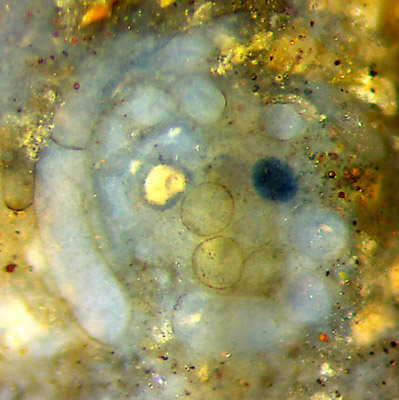
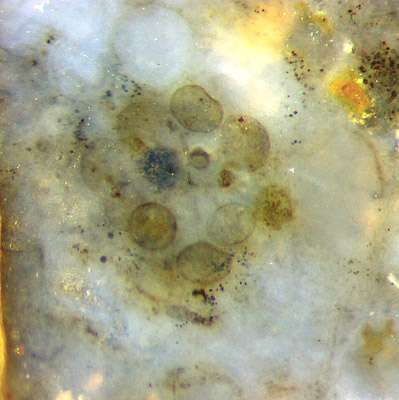
Fig.3:
Top view of an "alga flower" with capsules attached to a central column
(not seen here) with slender stalks, surrounding branches poorly
preserved. Picture size 1mm2.
Fig.4 (far right): Inclined view of an "alga
flower" with capsules, empty or filled, surrounding branches mostly cut
across, bluish. Picture size 1mm2.
As
more clearly seen in previous contributions, the capsules are
surrounded by curved branches forming a protective basket. These
baskets, arranged in a kind of umbel as seen in Rhynie
Chert News 89, are more or less lopsided so
that cuts may provide confusing
arrangements of parts. In Fig.3, one branch cross section is rather
large, 0.2mm. In Fig.4, one cell of the branch on the left, width
0.12mm, is seen in full length, 0.5mm. The
number of capsules, counting also the dimly seen ones in the depth,
seems to be 12 in Fig.3 and 6 in Fig.4. Capsules
with black fill are not rare (see
Rhynie
Chert News 73) but the one with white fill
seems to be
unique.
Anyway,
not the presence or absence of the various fills is the important
problem here but the very presence of the capsules is. The capsules do
not fit into the charophyte concept as we know it, with the well-known
gyrogonites as female organs. A strong hint is given by the presence,
in the same piece of chert, of globular organs not much different from
the likewise well-known antheridia of the conventional charophytes
(Figs.5,6).
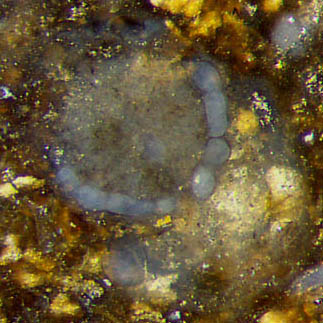
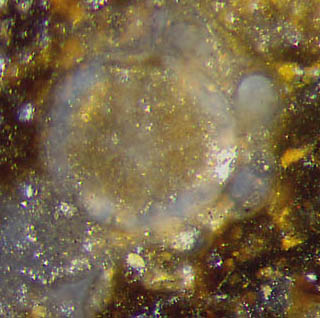 Figs.5,6:
Globular organs found near the new charophyte, most probably
antheridia, wrapped with narrow branches. Same scale as above, width
0.8mm.
Figs.5,6:
Globular organs found near the new charophyte, most probably
antheridia, wrapped with narrow branches. Same scale as above, width
0.8mm.
The presence of antheridia
strongly suggests an interpretation of the capsules in Figs.3,4 as
oogonia. This would make the charophyte faintly seen in Fig.1, like
similar specimens discovered recently, an archetype of all
charophytes, dating back to ages when the gyrogonites had not yet been
invented [4]. As an intriguing thought, many of the charophyte
specimens taken for Palaeonitella
might rather belong to the much
different new species.
Likewise undecided and inviting further research is the Nematoplexus
problem with tubes spiralling, weakly curved, or straight, with smooth
or stiffened walls, with the enigmatic "branch knots", with a variety
of sizes (as in Figs.1,2), all together in this small chert sample. The
fact that it is still uncertain to which branch of living beings the
nematophytes belong may contribute to the fascination with the subject.
All pictures taken from Sample Nr. Rh9/86, found in 2003.
H.-J.
Weiss
2017
[1] T.N. Taylor,
E.L. Taylor, M. Krings: Paleobotany, Elsevier 2009.
[2] A.G. Lyon:
On the fragmentary remains of an organism referable to the
nematophytales, from the Rhynie chert, Nematoplexus rhyniensis.
Trans. Roy. Soc. Edinburgh
65(1961-62), 79-87, 2 tables
[3] www.abdn.ac.uk/rhynie/nemato.htm
[4] H.-J.
Weiss:
First xanthophyte and new charophyte in the Rhynie chert.
87. Annual Conference of the
Paläontologische Gesellschaft, Dresden, 2016, 163.
 |
 |
106 |







 Figs.5,6:
Globular organs found near the new charophyte, most probably
antheridia, wrapped with narrow branches. Same scale as above, width
0.8mm.
Figs.5,6:
Globular organs found near the new charophyte, most probably
antheridia, wrapped with narrow branches. Same scale as above, width
0.8mm.
